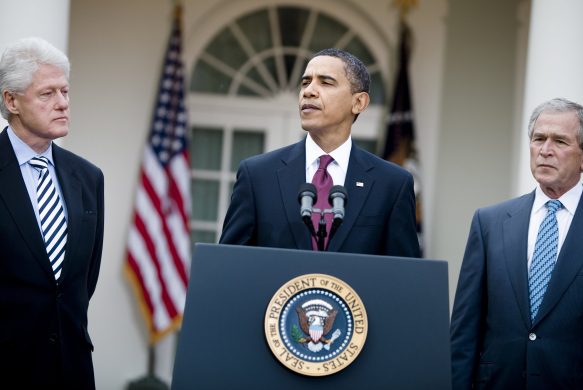I alle andre udviklingsregioner er flere end 50 procent af kvinderne i arbejde eller aktivt på udkig efter et. Men i MENA (Middle East and North Africa) er det kun 25,2 procent af kvinderne, der kan regnes som en del af arbejdsstyrken, konkluderer Verdensbanken.
WASHINGTON, September, 2011: Women worldwide continue to be at a disadvantage. They are not equally represented in positions of economic and political leadership, have higher unemployment rates than their male peers (partnere) and are paid less.
These gaps have been steadily narrowing across the world as women overcome the cultural and structural barriers to full equality. But in the Middle East and North Africa (MENA) region, they remain especially stubborn (stædige) and set against a particularly challenging background of high unemployment overall. To prevent unemployment rates from rising even further, by 2050 MENA will need to create almost 200 million more jobs, three-quarters of them for women.
Over the last 30 years, female participation in the MENA labor force has grown at a sluggish rate of just 0,17 percent annually. If this rate persists, it will take the region’s women 150 years to catch up with the rest of the developing world.
These statistics are both alarming and puzzling. They mask, and bear no apparent causal relationship with, dramatic improvements in a number of other social indices. Women in MENA have advanced beyond their developing world peers in literacy rates (analfabetisme), infant mortality and life expectancy. They have even exceeded gender parity (ligestilling) in some instances, resulting in ‘reverse gender gaps’ in areas such as tertiary education, where women now outnumber men.
Yet this has not translated into greater opportunities for the region’s women. The unemployment gap between men and women in MENA has been on the rise, doubling over the last 25 years, from 5 percent in 1985 to more than 10 percent in 2010.
THE MENA PARADOX AND THE ARAB SPRING
This conundrum (gåde) is one of the sources of the popular frustration that has fueled the Arab Spring. Young men and women, who have been at the forefront of calls for change, are demanding opportunities to exercise their talents, and to engage politically and economically.
Removing the obstacles to female participation in the labor force will insure that investments in their education and health are put to productive use. It will also put development on a more inclusive track, benefitting both women and future generations. Studies have shown that an increase in women’s financial independence and social standing has a direct impact on the welfare of children, as it leads to more investment in their health and education.
A TEACHER, A LAWYER, AN ENGINEER, A BROADCASTER
Oil and religion are often singled out as the culprits responsible for holding women back, yet neither factor fully explains the facts. Egypt and Indonesia share many common traits: they are both Muslim majority countries, with comparable oil reserves and export diversification. Despite these similarities, the rate of female employment in Egypt is half that of Indonesia.
Women in MENA also face a unique combination of legal and social pressures that limit where and when they can work, narrowing the field of available jobs and careers. Laws designed to protect women restrict the hours they can work, and in many countries, women require the permission of their male guardian to work. Employers also perceive women to be less productive or more costly to hire. Together, these perceptions and restrictions not only restrict women’s choice and mobility but also make them less attractive to employers. The cumulative effect is that few women make it into the workforce, and the ones that do find it very difficult to find employment.
These factors have in no way dampened the desire to work though. A 2010 World Bank survey of Jordanian female community college graduates found that 92 percent planned to look for work, with 76 percent expecting to be working full time.
A follow-up survey of the same graduates in 2011 discovered that only 7 percent of the married women were employed, as opposed to 21 percent of those who were still single, and 14 percent of those engaged. The desire to work had remained unchanged across the entire group.
BALANCING WORK AND FAMILY IS DIFFICULT
The conflicting demands of work and family life are a challenge the world over, and MENA is no exception. There are many ways to make family and work life more compatible, especially for young mothers. Flexible working hours, promoting women’s entrepreneurship and child care options can support women in their desire to build both careers and families, without rendering them any less attractive than potential male employees.
There will have to be more choice when it comes to career paths, in an expanded and diverse private sector capable of absorbing the growing number of educated women intent on working.
RENEGOTIATING THE SOCIAL CONTRACT
MENA economies have long been dominated by large public sectors and a social contract under which the response to economic and social unrest has been the expansion of government jobs and increased subsidies. This system is rapidly breaking down under the combined weight of pressure on national budgets (and a public sector unable to meet the rising demand for jobs), and the call of the Arab Spring for more open and inclusive government.
In this changing mix, the educational choices of MENA women are still geared toward the public sector, resulting in a lack of the sorts of skills required by the private sector. There are a number of ways of overcoming this mismatch of skills, such as scholarships and internships that provide on-the-job training in a self-sustaining cycle in which employers are given first-hand experience of female employees to dispel any myths about their productivity or long-term commitment. The result will be that employers will not hesitate before deciding to invest in the development of the next potential female employee. The women will become role models for the next generation, encouraging them to acquire the right skills and strive for a similar career.
Kilde: www.worldbank.org














